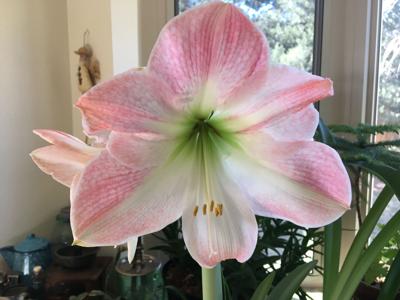As the holidays approach and we put our gardens to bed for the season, we can bring color to our indoor spaces with flowering bulbs. The exotic and showy blooms of amaryllis are just the thing!
Amaryllis are easy to grow and make lovely gifts; available as bare or potted bulbs, hybrid varieties come in several colors including red, white and shades of pink, coral and burgundy. If purchasing from a garden center, select large bulbs that are firm and dry, with no signs of mold or damage. If new growth is visible, it should be bright green.
Plant the bulb in a narrow container of any type with good drainage, approximately 1 inch wider than the bulb’s widest point and twice as tall as the bulb. Fill the container with new, sterile potting soils about half full and set bulb roots on the soil. Raise the soil level, if needed, so the top of the bulb sits above the rim of the pot. Add soil around the bulb and tamp down so that a third to a half of the bulb is still visible. Water thoroughly until soil is evenly moist. Drain and place on a saucer in a sunny window.
Whenever the top 2 inches of soil feels dry, water thoroughly. Fertilize monthly with ½-strength fertilizer formulated for blooming plants. To determine if a fertilizer is formulated for flowering plants, look at the NPK percentages on the packaging. Nitrogen (N) will be the first percentage followed by phosphorous (P), then potassium (K); to stimulate flowering, look for products with a phosphorous percentage equal or greater than the nitrogen percentage.
Keep the potted bulb in a sunny location (but not direct sun). It will take four to six weeks for flower buds to appear. Amaryllis are highly phototropic — this means the stalk grows or “bends” toward the light. Rotate the plant as it grows to keep the flower stalk straight.
After the flowers fade, remove the spent blooms but don’t cut the stalk until it yellows and begins to die back. Continue to care for the plant much like any green houseplant. The green stalk and the leaves conduct photosynthesis, storing energy in the bulb for future flowering.
In spring, after the danger of frost has passed, amaryllis bulbs can be moved outdoors, in the pot — at first to a partially shady location until the plant adjusts, then gradually to a sunnier spot. The bulb can also be planted in the ground. Continue to fertilize as you did indoors. In fall, bring the plant back indoors before the first frost. Amaryllis are not cold hardy and won’t survive Colorado’s harsh winters outdoors.
For more information about promoting reblooming, check out this link.
https://extension.unh.edu/blog/2019/01/can-i-get-my-amaryllis-bloom-again
Submit gardening questions to csumg2@elpasoco.com . They will be answered via our remote help desk system. The in-person Help Desk is closed for the winter; it will reopen in spring. Find us on Facebook at Colorado Master Gardeners — El Paso County.






 Your Privacy Choices
Your Privacy Choices